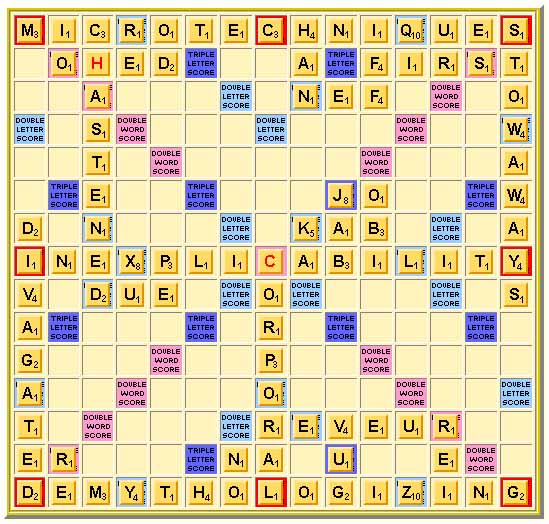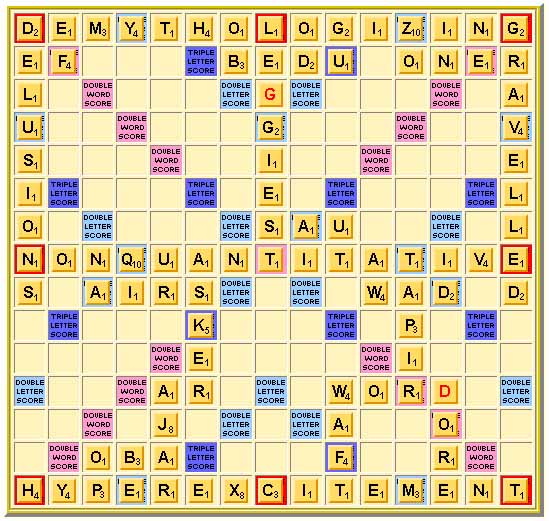Scrabble
I'm going to explain my pet Scrabble project here, because I'm rather proud of it. It's a bit convoluted. It's probably terribly boring. If you don't want to know about the ins and outs, just scroll down to the bottom and look at the end results.
Basically, I designed some Scrabble games. The aim was to find the highest possible Scrabble scores, in the following contexts: combined score over a whole game, individual game score and highest score in one single play. I then played the games online at the PixiePit Scrabble website.
What I was trying to do was engineer a Scrabble game so that every single move resulted in the highest possible score.
When aiming for a high overall score, one of the most important things is to make sure every triple-word score on the board is covered. Not only that, but you want (ideally) three fifteen-letter words. Each of these needs to cover three triple-word scores (TWSs) at once. Even further, you need all three of the TWSs to be covered in one play. As you can't play more than seven letters at a time, this means that at least eight of these letters need to be already on the board. You also want high-scoring letters (ideally K, X, Q or Z) to be sitting on the double-letter scores that are at the edge of the board.
So you’re looking for fifteen-letter words that have smaller words within them, in such a way that you can place seven new letters on the board (which are ideally high-scoring letters), which cover both double-letter scores and all three triple-word scores. The reason for covering all three triple-word scores in one go is that they are applied to each other. So you get to multiply your total score by (3x3x3), which is 27, and allows you to get closer to the ultimate goal of 4000 for the whole game (I never achieved this goal - sob).
For example, the word "demythologizing" is fifteen letters long. If this word is placed at the edge of the board (or across the middle), the letter Y (4 points) and and the letter Z (10 points) both sit on double-letter scores. The D, the L, and the final G all sit on triple-word scores. "Em", "Ho", "Gi" and "In" are all allowable words according to the international tournament Scrabble dictionary (aka SOWPODS). These smaller words are all contained within the larger word. As long as you can get them all placed on the board on the board in the correct positions, you can then play D, Y, T, L, O, Z and G in one go. In this go you will cover three triple-word scores, two double-letter scores (one with a Y and one with a Z), AND you use up all your letters (an extra 7 points) AND you create a fifteen-letter word.
The final challenge is to also have other words connected to the triple-word scores in a different direction, so that you score for them, too. In the second example below, you'll see that the words "elusion", "eggiest" and "ravelled" were already on the board, in useful positions, when the word "Demythologizing" was played. The D, L and G (placed on triple-word scores) turned these three words into "delusions", "leggiest" and "gravelled". The result was an individual score of 1493, in just one go.
My favourite thing about this particular move is that "demythologizing" is such a great word, and describes what I was trying to do at the time. I was in good-natured competition with a couple of other Scrabble players on the PixiePit, who were also trying to create the perfect Scrabble game. They liked to joke that they had some kind of magical skills, and that nobody could possibly ever beat them. The demythology of the highest-ever PixiePit score created by playing the "demythologizing" game was very satisfying!
The work involved in designing a high-scoring game didn't stop at thinking of ways to gain the high scores. The games then had to be played. I played them online at the PixiePit Scrabble website.
The PixiePit does not allow fixing or cheating, so I had to play out each game as if it were a real game. The obvious problem here is that you are allocated letters randomly, and therefore you can't guarantee you'll get the letters you want. In order to achieve a high individual score, you want all the points in the game to be won by one player only. This means that one player, the "patsy", has to pass on every turn. The other player then has to keep swapping letters until they have exactly the hand that they need to play the pre-organised play.
The business of swapping letters until you get what you want can involve literally hundreds of letter-swaps. Each game would take me several hours to complete, over a period of days. It was very tedious, but I have an obsessive streak, and once I started each game I simply couldn't stop. Concentration was required, as the tiniest mistake could set you back to square one.
You also need to be absolutely sure that your design is sound. It's not enough to have a board with letters and words sitting in high-scoring places. You need to be sure that each word is placeable in a valid Scrabble move. This can lead to pitfalls. For instance, it's no good having two words linked by another if the linking word is too long to be played in one go, and can't be broken down into playable smaller words.
There's a lot of maths involved in calculating the best way to achieve a high score. But I'm not only obsessed with words. I'm obsessed with numbers too. Which is why Scrabble is the perfect game for me! And yes, I'm clearly a complete nutter. I had to give up designed Scrabble games in the end because Ally was starting to get shirty about the fact that he never saw me. Plus I wasn't getting any sleep.
Ally and I do also play ordinary (i.e. not fixed) games of Scrabble, and we both tend to average an individual score of around 350. We have been known to approach a combined score of 900, but this is very rare for us.
Some example high-scoring Scrabble games.
The PixiePit Hall of Fame II shows all the high scores achieved in designed Scrabble games.
The one below had an individual score for one player of 3658. The combined score for both players was 3674:

The one below included a score of 1493, which was obtained in just one go, when D, Y, T, L, O, Z and G were placed on the board to make the 15-letter word "demythologizing" (as well as "delusions", "leggiest" and "gravelled"):

If you want to know even more, read this interview on the subject, where I go on about it all at great length.
|